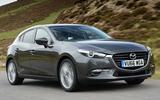What is it?
A mildly updated version of the Mazda 3 hatchback and a rival for almost everything else in the C segment. Mazda names the Kia Ceed and Hyundai i30 as the cars it most wants to compete against, but in truth the 3 is taking on everything from the Ford Focus to the Skoda Octavia.
Until now, the 3 has been well received. We like its interior space, economical diesel engines and agile handling, but with the car having been on sale since 2013 - and the next-generation 3 not due until 2018 - updates were needed to keep it competitive.

Changes to the car's styling are minor, including a new grille to put the car more in line with the Mazda CX-3 and facelifted Mazda 6 saloon, new LED headlights and a revised rear bumper, but it's in the chassis where most of the work has been done. Mazda's G-Vectoring Control (GVC) system is new here, although it already features in the 6. It delivers minute and imperceptible variations in engine torque to the front wheels, allowing the 3 to corner with more stability and reducing the need for mid-corner steering inputs from the driver. It's also claimed to improve ride comfort for passengers by reducing mid-corner lateral forces.
Also new are various interior upgrades: there's a new plastic trim around the window switches, larger door bins, a full-colour head-up display on Sport Nav models and a new leather steering wheel. Mazda has also done away with its mechanical handbrake in favour of an electric version.























Join the debate
Add your comment
Consistant character
Mazda make cars with character and a consistent well engineered feel, quality mechanical movement and sound contributes to give the cars that very character which is being filtered out of German brands in their constant pursuit of quietness.
Inconsistently weighted steering? Really??
Low CO2 no longer matters much